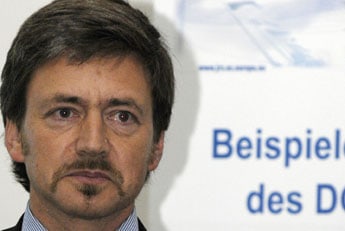
By Margaret Harris in Washington DC
One July day not so long ago, a shipment of scrap metal entered an EU seaport from somewhere outside the EU. No-one who watched the shipment being unloaded saw anything out of the ordinary. But when it went through the port’s radiation detector, alarm bells began to ring – and they rang again the next month with another shipment, and for a third time in October the same year. What was going on?
This is the story of “Find 33,” a case study from the emerging science of nuclear forensics that formed the basis of Klaus Mayer’s talk at an AAAS session on combating nuclear terrorism. Mayer, a scientist at the Institute for Transuranium Elements (ITU) in Karlsruhe, Germany, was called to investigate Find 33 after national authorities had isolated which particular bits of scrap were setting off the detectors.
The initial data were puzzling. The amount of enriched uranium in the four pieces of suspicious scrap ranged from a few percent to over 90% – values that suggested a mixture of commercial-grade and weapons- or research-reactor grade contamination. Could they have a common origin? Or were Mayer and his team dealing with multiple uncontrolled sources of radioactive and nuclear material?
After more detailed tests, a clearer picture began to emerge. A sample from the first piece of scrap – an extremely dirty funnel-shaped object – was found to contain 0.33% uranium by weight, of which the fraction of enriched uranium (U-235, the isotope used in both nuclear weapons and reactor fuel) was 9%. This was unusual: 9% is too high for a commercial reactor, which typically uses fuel that is 90%). However, after grinding the sample into powder, Mayer and his team were able to show that it was actually a mixture of 3.6%-enriched and 20%-enriched particles. Radiochemical tests also showed that the uranium in it was old – it hadn’t been chemically purified since 1962.
 A piece of contaminated scrap from Find 33. (Courtesy: VROM-Inspectorate)
A piece of contaminated scrap from Find 33. (Courtesy: VROM-Inspectorate)The other three scraps were analysed in a similar fashion, turning up a mixture of ages (June 1959, June 1972, October 1983) and enrichment fractions that ranged from a few percent for the second scrap to a sobering 89% for the fourth. This indicated that wherever these scraps had come from, it had to be someplace that had been producing a mixture of light-water reactor fuel, fast-breeder reactor fuel, submarine fuel and material for research reactors or weapons for at least 30 years, between the late 1950s and early 1980s.
And there were only two sites that fit the bill.
Sadly for this story’s narrative arc, Mayer declined to provide any further information on the two candidate facilities, citing an ongoing investigation. One thing, however, is certain: with 207 illicit trafficking incidents recorded in 2010 alone, the atomic detectives are keeping busy.



